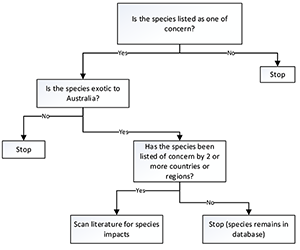Authors: Jessica Evans, Alexander Brazenor, Bertie Hennecke and Sandra Parsons
Overview

This report provides details of the method used to develop a database of exotic invasive species that have the potential to have environmental impacts in Australia. The report also provides an overview of species contained in the database.
Key issues

- Previous introductions of invasive species (for example, European fox, European carp and lantana) - many of them intentional - have had significant impacts on Australia's environment. Invasive species threaten biodiversity, cause environmental degradation and reduce the diversity and abundance of native species. Impacts on the environment can have flow-on effects - impacting tourism and the economy more broadly. Preparedness activities, such as identifying exotic species (and their pathways) that are a major threat to Australia's industry, environment and social amenity, are important steps in mitigating the risk of incursions.
- To strengthen environmental biosecurity preparedness, the Stronger Biosecurity and Quarantine Initiative commissioned ABARES to identify exotic invasive species that have the potential to impact the environment. A horizon scanning approach was adopted by scanning databases, government data, legislation, scientific journals and reports for invasive species (plants, vertebrates and invertebrates) recorded around the world. Species identified from these sources were recorded in a database.
- This report describes the methods used to develop this database and provides an overview of species in the database at July 2017. At July 2017 the database contained approximately 430 plant, 800 vertebrate and 815 exotic invertebrate species identified as invasive or as a concern in countries and regions across the world. Species that were exotic and of concern for two or more countries/regions were further examined for their impacts (environment, agriculture and social), resulting in 160 plant, 177 vertebrate and 208 invertebrate species examined for the purpose of this report. Although a comprehensive evaluation of the impacts of these species was not performed, scanning of literature suggested that 43 per cent of the plants, 58 per cent of the vertebrates and 36 per cent of the invertebrates had at least some documented impacts on the environment in their overseas range.
- The database is not an official or exhaustive list of exotic species of concern. This project is the first step of a proposed broader invasive species prioritisation framework - the identification of exotic species. The invasive species prioritisation framework has been designed to inform future policy development and to support arrangements for prevention, preparation and national eradication and management.
